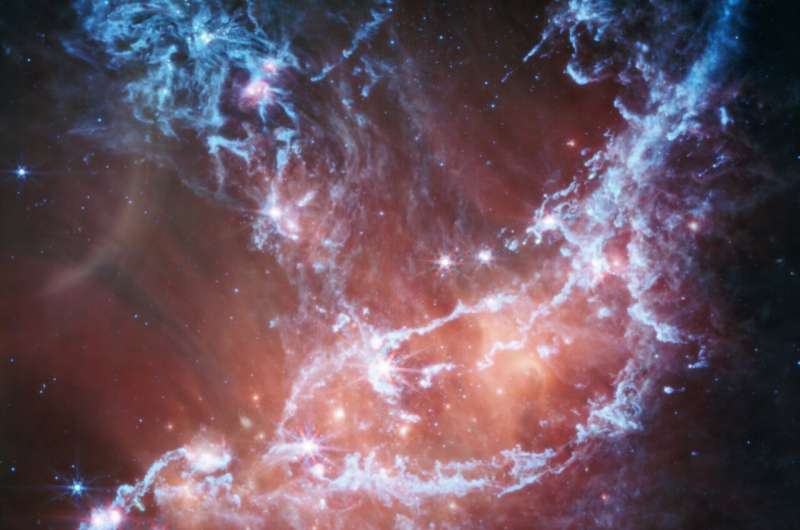This article has been reviewed according to Science X's editorial process and policies. Editors have highlighted the following attributes while ensuring the content's credibility:
fact-checked
trusted source
proofread
NASA's Webb captures an ethereal view of NGC 346

Within a neighboring dwarf galaxy known as the Small Magellanic Cloud (SMC) lies a dramatic region of star birth—NGC 346, shown here. As the brightest and largest star-forming region in the SMC, it has been studied intensely by a variety of telescopes. NASA's Hubble Space Telescope showed a visible-light view filled with thousands of stars. More recently, NASA's James Webb Space Telescope offered a near-infrared vista highlighting both cool and warm dust. Now, Webb has turned its mid-infrared gaze to NGC 346, revealing streamers of gas and dust studded with bright patches filled with young protostars.
One of the greatest strengths of NASA's James Webb Space Telescope is its ability to give astronomers detailed views of areas where new stars are being born. The latest example, showcased here in a new image from Webb's Mid-Infrared Instrument (MIRI), is NGC 346—the brightest and largest star-forming region in the Small Magellanic Cloud.
The Small Magellanic Cloud (SMC) is a satellite galaxy of the Milky Way, visible to the unaided eye in the southern constellation Tucana. This small companion galaxy is more primeval than the Milky Way in that it possesses fewer heavy elements, which are forged in stars through nuclear fusion and supernova explosions, compared to our own galaxy.
Since cosmic dust is formed from heavy elements like silicon and oxygen, scientists expected the SMC to lack significant amounts of dust. However the new MIRI image, as well as a previous image of NGC 346 from Webb's Near-Infrared Camera released in January, show ample dust within this region.
In this representative-color image, blue tendrils trace emission from material that includes dusty silicates and sooty chemical molecules known as polycyclic aromatic hydrocarbons, or PAHs. More diffuse red emission shines from warm dust heated by the brightest and most massive stars in the heart of the region. An arc at the center left may be a reflection of light from the star near the arc's center. (Similar, fainter arcs appear associated with stars at lower left and upper right.) Lastly, bright patches and filaments mark areas with abundant numbers of protostars. The research team looked for the reddest stars, and found 1,001 pinpoint sources of light, most of them young stars still embedded in their dusty cocoons.
By combining Webb data in both the near-infrared and mid-infrared, astronomers are able to take a fuller census of the stars and protostars within this dynamic region. The results have implications for our understanding of galaxies that existed billions of years ago, during an era in the universe known as "cosmic noon," when star formation was at its peak and heavy element concentrations were lower, as seen in the SMC.
Provided by NASA





















